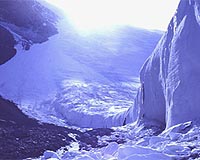| . |  |
. |
Paris (AFP) Sept 7, 2010 Estimates of the rate of ice loss from Greenland and West Antarctica, one of the most worrying questions in the global warming debate, should be halved, according to Dutch and US scientists. In the last two years, several teams have estimated Greenland is shedding roughly 230 gigatonnes of ice, or 230 billion tonnes, per year and West Antarctica around 132 gigatonnes annually. Together, that would account for more than half of the annual three-millimetre (0.2 inch) yearly rise in sea levels, a pace that compares dramatically with 1.8mm (0.07 inches) annually in the early 1960s. But, according to the new study, published in the September issue of the journal Nature Geoscience, the ice estimates fail to correct for a phenomenon known as glacial isostatic adjustment. This is the term for the rebounding of Earth's crust following the last Ice Age. Glaciers that were kilometers (miles) thick smothered Antarctica and most of the northern hemisphere for tens of thousands of years, compressing the elastic crust beneath it with their titanic weight. When the glaciers started to retreat around 20,000 years ago, the crust started to rebound, and is still doing so. This movement, though, is not just a single vertical motion, lead researcher Bert Vermeersen of Delft Technical University, in the Netherlands, said in phone interview with AFP. "A good analogy is that it's like a mattress after someone has been sleeping on it all night," he said. The weight of the sleeper creates a hollow as the material compress downwards and outwards. When the person gets up, the mattress starts to recover. This movement, seen in close-up, is both upwards and downwards and also sideways, too, as the decompressed material expands outwards and pulls on adjacent stuffing. Often ignored or considered a minor factor in previous research, post-glacial rebound turns out to be important, says the paper. It looks at tiny changes in Earth's gravitational field provided by two satellites since 2002, from GPS measurements on land, and from figures for sea floor pressure. These revealed, among other things, that southern Greenland is in fact subsiding, as the crust beneath it is pulled by the post-glacial rebound from northern America. With glacial isostatic adjustment modelled in, the loss from Greenland is put at 104 gigatonnes, plus or minus 23 gigatonnes, and 64 gigatonnes from West Antarctica, plus or minus 32 gigatonnes. These variations show a large degree of uncertainy, but Vermeersen believes that even so a clearer picture is emerging on icesheet loss. "The corrections for deformations of the Earth's crust have a considerable effect on the amount of ice that is estimated to be melting each year," said Vermeersen, whose team worked with NASA's Jet Propulsation Laboratory and the Netherlands Institute for Space Research. "We have concluded that the Greenland and West Antarctica ice caps are melting at approximately half the speed originally predicted." If the figures for overall sea level rise are accurate, icesheet loss would be contribute about 30 percent, rather than roughly half, to the total, said Vermeersen. The rest would come mainly from thermal expansion, meaning that as the sea warms it rises. The debate is important because of fears that Earth's biggest reservoirs of ice, capable of driving up ocean levels by many metres (feet) if lost, are melting much faster than global-warming scenarios had predicted. In 2007, the UN's Intergovernmental Panel on Climate Change (IPCC) predicted oceans would rise by 18-59 centimeters (7.2 and 23.6 inches) by 2100, a figure that at its upper range means vulnerable coastal cities would become swamped within a few generations. The increase would depend on warming estimated at between 1.1 and 6.4 degrees Celsius (1.98-11.52 degrees Fahrenheit) this century, the IPCC said. It stressed, though, the uncertainties about icesheet loss.
Share This Article With Planet Earth
Related Links Beyond the Ice Age
 Researchers Find A 'great Fizz' Of Carbon Dioxide At The End Of The Last Ice Age
Researchers Find A 'great Fizz' Of Carbon Dioxide At The End Of The Last Ice AgeNew Brunswick NJ (SPX) Aug 31, 2010 Imagine loosening the screw-top of a soda bottle and hearing the carbon dioxide begin to escape. Then imagine taking the cap off quickly, and seeing the beverage foam and fizz out of the bottle. Then, imagine the pressure equalizing and the beverage being ready to drink. Rutgers marine scientist Elisabeth Sikes and her colleagues say that something very similar happened on a grand scale ov ... read more |
|
| The content herein, unless otherwise known to be public domain, are Copyright 1995-2010 - SpaceDaily. AFP and UPI Wire Stories are copyright Agence France-Presse and United Press International. ESA Portal Reports are copyright European Space Agency. All NASA sourced material is public domain. Additional copyrights may apply in whole or part to other bona fide parties. Advertising does not imply endorsement,agreement or approval of any opinions, statements or information provided by SpaceDaily on any Web page published or hosted by SpaceDaily. Privacy Statement |